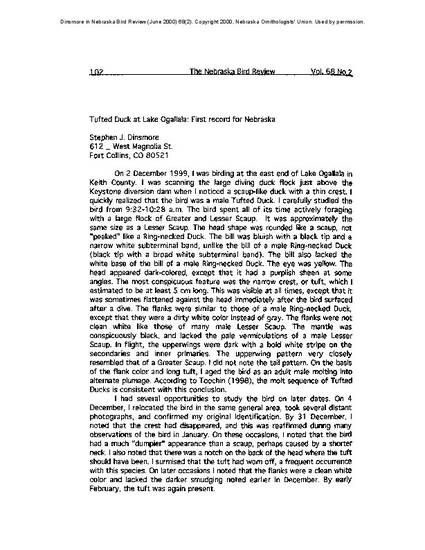
On 2 December 1999, I was birding at the east end of Lake Ogallala in Keith County. I was scanning the large diving duck flock just above the Keystone diversion dam when I noticed a scaup-like duck with a thin crest. I quickly realized that the bird was a male Tufted Duck. I carefully studied the, bird from 9:32-10:28 a.m. The bird spent all of its time actively foraging with a large flock of Greater and Lesser Scaup. It was approximately the same size as a Lesser Scaup. The head shape was rounded like a scaup, not "peaked" like a Ring-necked Duck. The bill was bluish with a black tip and a narrow white subterminal band, unlike the bill of a male Ring-necked Duck (black tip with a broad white subterminal band). The bill also lacked the white base of the bill of a male Ring-necked Duck. The eye was yellow. The head appeared dark-colored, except that it had a purplish sheen at some angles. The most conspicuous feature was the narrow crest, or tuft, which I estimated to be at least 5 cm long. This was visible at all times, except that it was sometimes flattened against the head immediately after the bird surfaced after a dive. The flanks were similar to those of a male Ring-necked Duck, except that they were a dirty white color instead of gray. The flanks were not clean white like those of many male Lesser Scaup. The mantle was conspicuously black, and lacked the pale vermiculations of a male Lesser Scaup. In flight, the upperwings were dark with a bold white stripe on the secondaries and inner primaries. The upperwing pattern very closely resembled that of a Greater Scaup. I did not note the tail pattern. On the basis of the flank color and long tuft, I aged the bird as an adult male molting into alternate plumage. According to Toochin (1998), the molt sequence of Tufted Ducks is consistent with this conclusion.
Available at: http://works.bepress.com/stephen_dinsmore/44/

Dinsmore in Nebraska Bird Review (June 2000) 68(2). Copyright 2000, Nebraska Ornithologists' Union. Used by permission.